Abstract
1. The aim of this study was to investigate whether global ischaemia and reperfusion in rat isolated hearts affects endothelium-dependent vasodilatation and adrenoceptor-mediated vasoconstriction. In addition, it was first determined whether inhibition of the actions of nitric oxide (NO) influenced the responses to alpha-adrenoceptor agonists in the rat coronary vasculature. 2. In rat isolated, Langendorff perfused hearts, inhibition of NO with haemoglobin (Hb, 6 microM) significantly inhibited the vasodilator responses to the endothelium-dependent vasodilators, acetylcholine (ACh, 3-100 pmol), carbachol (CCh, 10-300 pmol), bradykinin (Bk, 1-30 pmol) and histamine (0.3-10 nmol) but did not affect responses to the endothelium-independent vasodilator, sodium nitroprusside (SNP, 0.01-1 nmol). 3. Inhibition of the action of NO by Hb significantly enhanced the vasoconstrictor response to the non-selective alpha-adrenoceptor agonist, noradrenaline (NA, 0.1-10 nmol) and the alpha 2-adrenoceptor agonist, B-HT 920 (0.001-1 mumol) but had no effect on the vascular response to the alpha 1-adrenoceptor agonist, methoxamine (MTX, 10-300 nmol). 4. In the perfused hearts ischaemia, induced by 30 min perfusion at 5% of the normal rate of flow, followed by 15 min of reperfusion (ischaemia/reperfusion) selectively impaired the vasodilator responses to ACh and CCh which act by muscarinic receptor stimulation but did not affect responses to the other endothelium-dependent vasodilators Bk and histamine or to the endothelium-independent dilator SNP. 5. After ischaemia/reperfusion the coronary vasoconstrictor responses to B-HT 920 were slightly but significantly enhanced whereas the responses to NA and MTX were unaffected. 6. Thus, in the rat isolated heart, low flow induced-ischaemia and reperfusion causes a selective impairment of muscarinic receptor-mediated vasodilatation but does not impair responses to all endothelium-dependent vasodilators. Enhanced constrictor responses to noradrenaline and B-HT 920 in the presence of Hb indicates that endogenous NO modulates the constriction of coronary resistance vessels in response to stimulation of alpha 2-adrenoceptors. Ischaemia and reperfusion in this isolated vascular bed caused only a small increase in the coronary vasoconstrictor response to alpha 2-adrenoceptor stimulation. It appears that in the rat isolated heart the degree of endothelial dysfunction caused by ischaemia/reperfusion is insufficient to cause a functionally significant change in alpha-adrenoceptor-mediated constriction.
Full text
PDF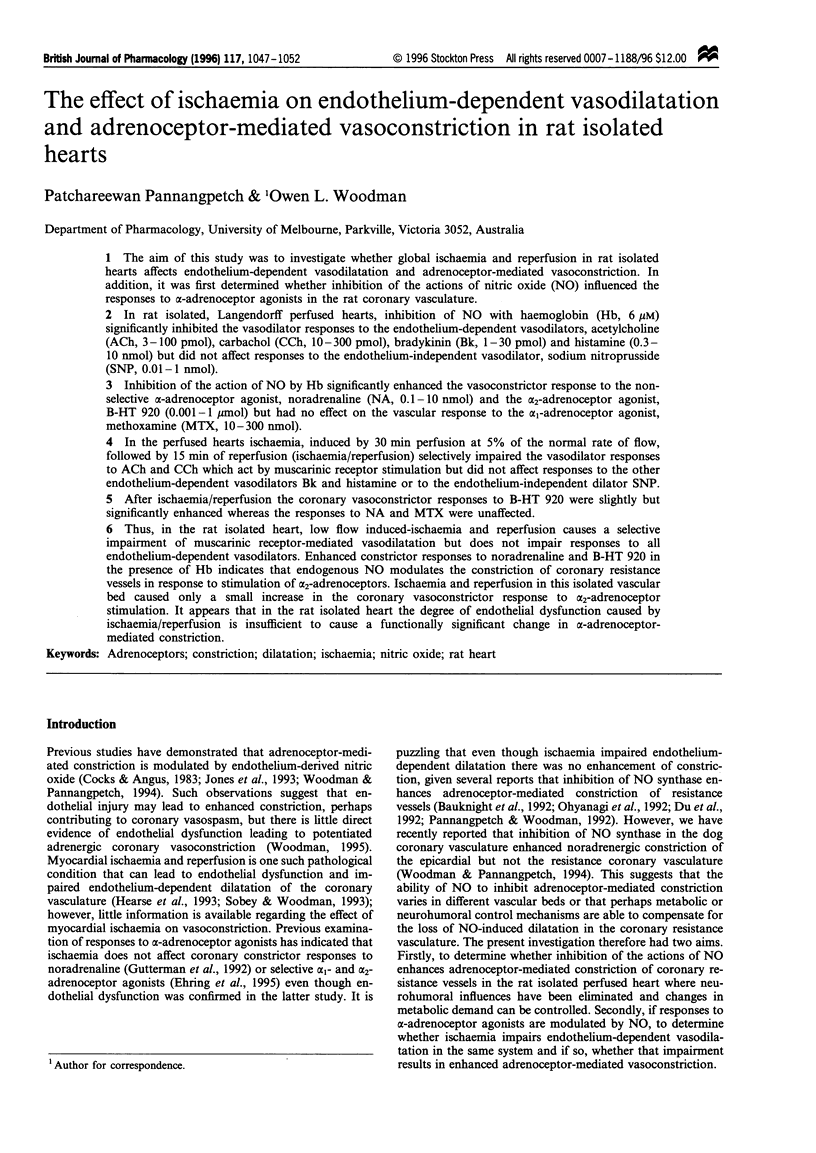
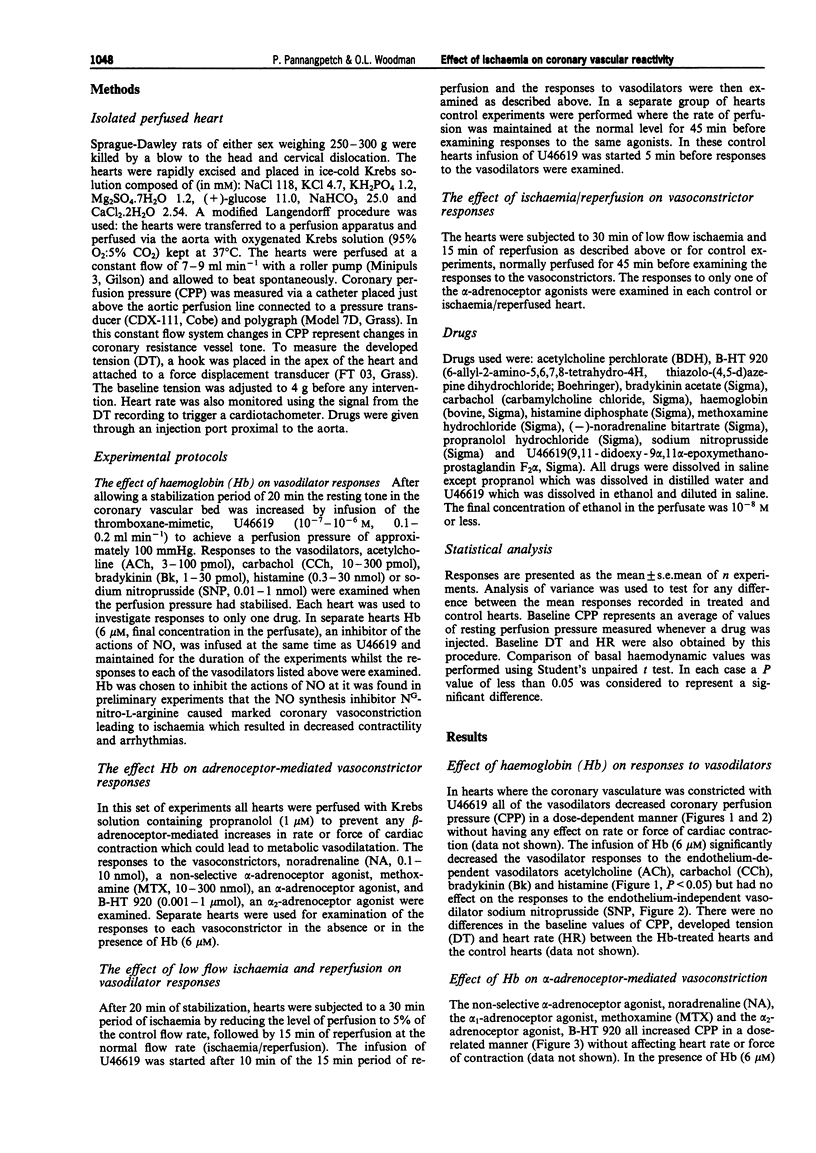
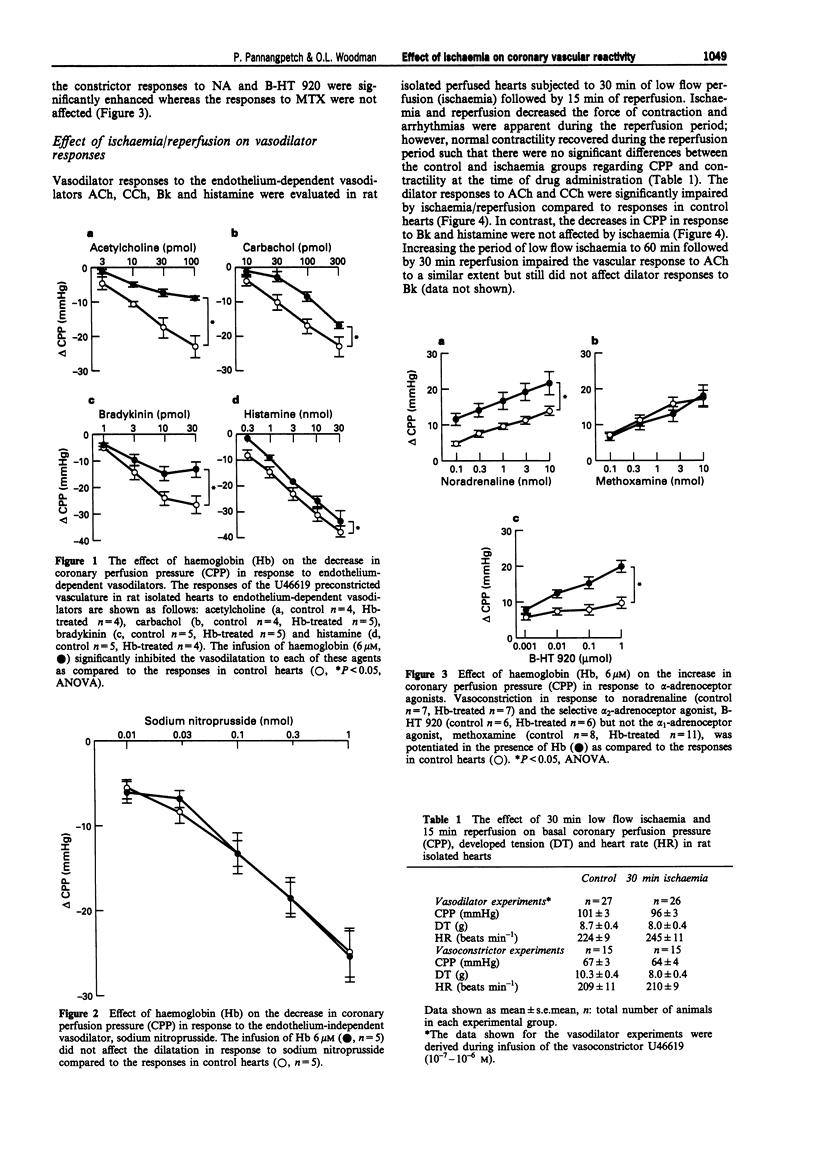
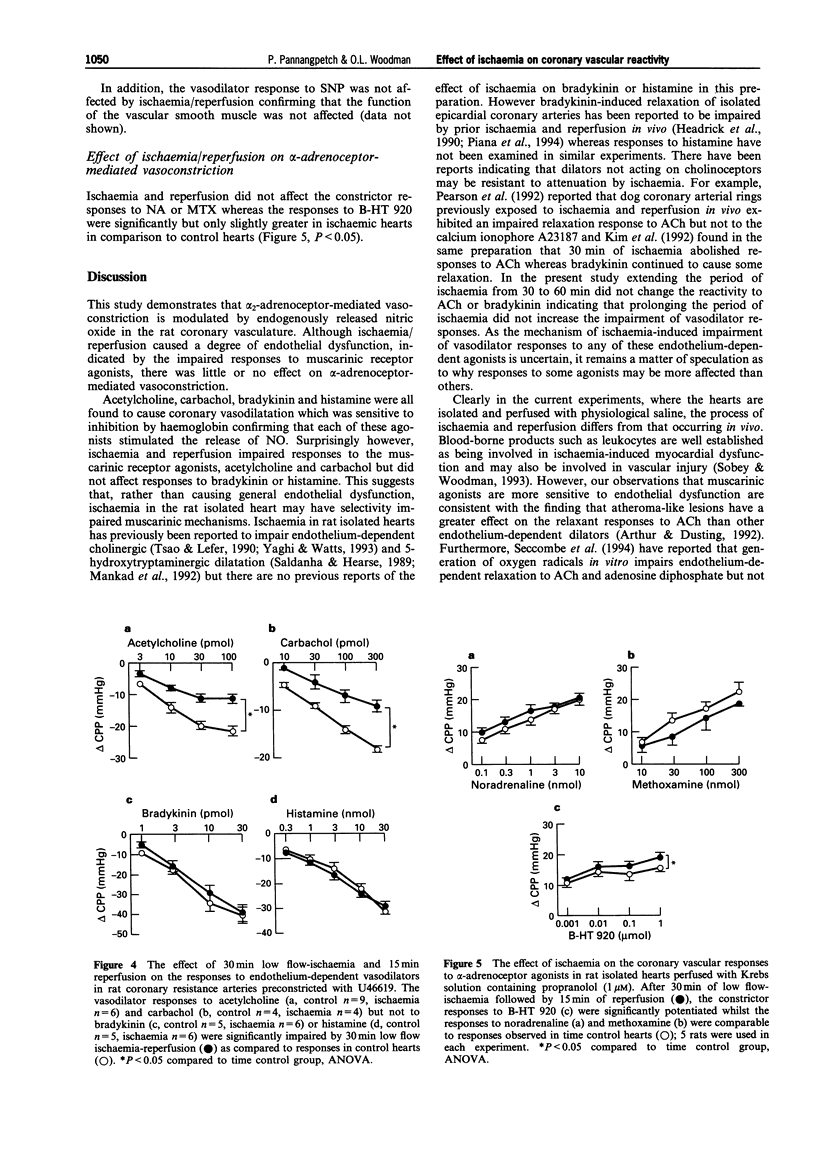
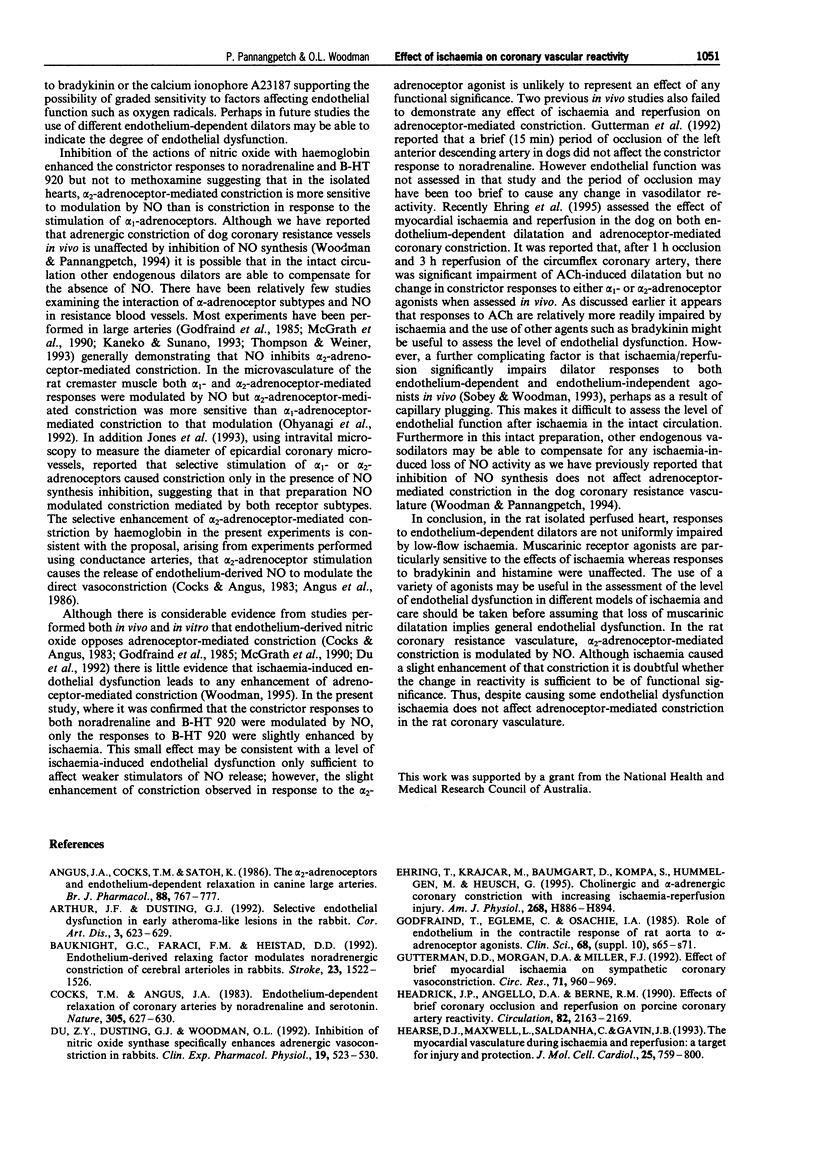
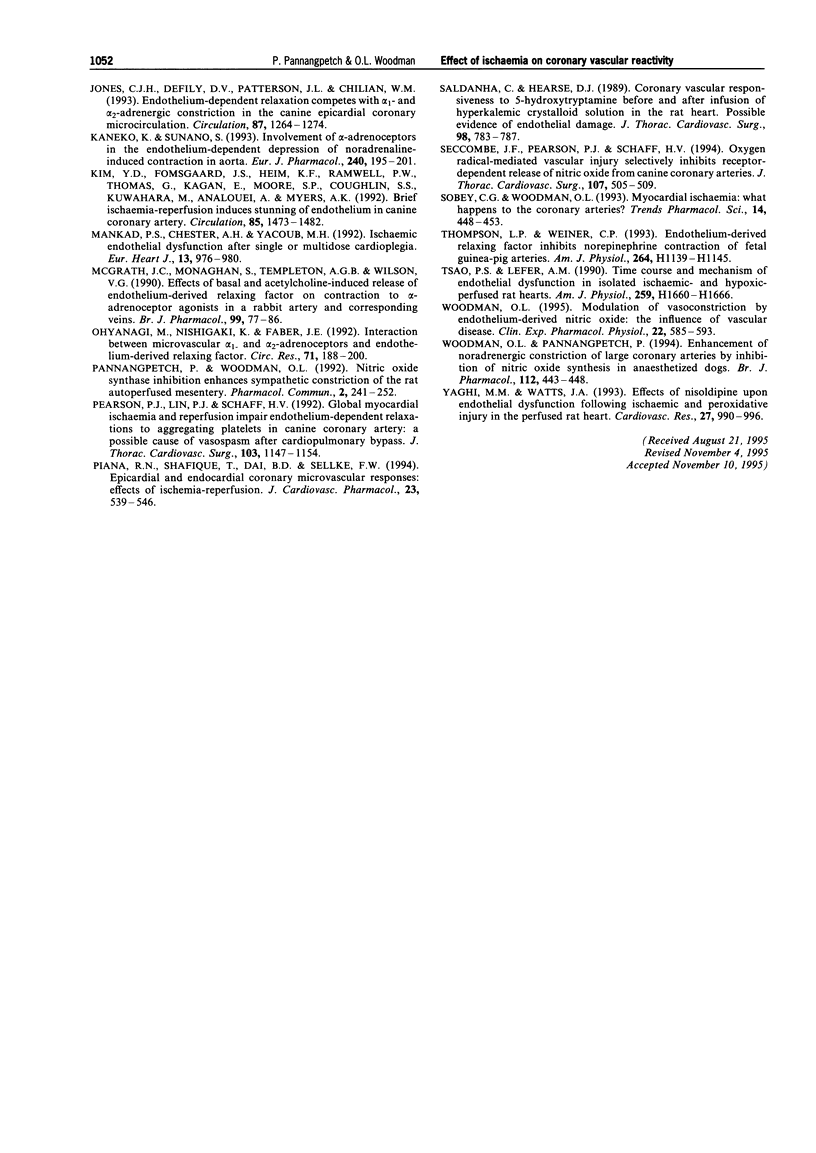
Selected References
These references are in PubMed. This may not be the complete list of references from this article.
- Angus J. A., Cocks T. M., Satoh K. Alpha 2-adrenoceptors and endothelium-dependent relaxation in canine large arteries. Br J Pharmacol. 1986 Aug;88(4):767–777. doi: 10.1111/j.1476-5381.1986.tb16249.x. [DOI] [PMC free article] [PubMed] [Google Scholar]
- Bauknight G. C., Jr, Faraci F. M., Heistad D. D. Endothelium-derived relaxing factor modulates noradrenergic constriction of cerebral arterioles in rabbits. Stroke. 1992 Oct;23(10):1522–1526. doi: 10.1161/01.str.23.10.1522. [DOI] [PubMed] [Google Scholar]
- Cocks T. M., Angus J. A. Endothelium-dependent relaxation of coronary arteries by noradrenaline and serotonin. Nature. 1983 Oct 13;305(5935):627–630. doi: 10.1038/305627a0. [DOI] [PubMed] [Google Scholar]
- Du Z. Y., Dusting G. J., Woodman O. L. Inhibition of nitric oxide synthase specifically enhances adrenergic vasoconstriction in rabbits. Clin Exp Pharmacol Physiol. 1992 Jul;19(7):523–530. doi: 10.1111/j.1440-1681.1992.tb00499.x. [DOI] [PubMed] [Google Scholar]
- Ehring T., Krajcar M., Baumgart D., Kompa S., Hümmelgen M., Heusch G. Cholinergic and alpha-adrenergic coronary vasomotion [corrected] with increasing ischemia-reperfusion injury. Am J Physiol. 1995 Feb;268(2 Pt 2):H886–H894. doi: 10.1152/ajpheart.1995.268.2.H886. [DOI] [PubMed] [Google Scholar]
- Gutterman D. D., Morgan D. A., Miller F. J. Effect of brief myocardial ischemia on sympathetic coronary vasoconstriction. Circ Res. 1992 Oct;71(4):960–969. doi: 10.1161/01.res.71.4.960. [DOI] [PubMed] [Google Scholar]
- Headrick J. P., Angello D. A., Berne R. M. Effects of brief coronary occlusion and reperfusion on porcine coronary artery reactivity. Circulation. 1990 Dec;82(6):2163–2169. doi: 10.1161/01.cir.82.6.2163. [DOI] [PubMed] [Google Scholar]
- Hearse D. J., Maxwell L., Saldanha C., Gavin J. B. The myocardial vasculature during ischemia and reperfusion: a target for injury and protection. J Mol Cell Cardiol. 1993 Jul;25(7):759–800. doi: 10.1006/jmcc.1993.1089. [DOI] [PubMed] [Google Scholar]
- Jones C. J., DeFily D. V., Patterson J. L., Chilian W. M. Endothelium-dependent relaxation competes with alpha 1- and alpha 2-adrenergic constriction in the canine epicardial coronary microcirculation. Circulation. 1993 Apr;87(4):1264–1274. doi: 10.1161/01.cir.87.4.1264. [DOI] [PubMed] [Google Scholar]
- Kaneko K., Sunano S. Involvement of alpha-adrenoceptors in the endothelium-dependent depression of noradrenaline-induced contraction in rat aorta. Eur J Pharmacol. 1993 Aug 24;240(2-3):195–200. doi: 10.1016/0014-2999(93)90898-r. [DOI] [PubMed] [Google Scholar]
- Kim Y. D., Fomsgaard J. S., Heim K. F., Ramwell P. W., Thomas G., Kagan E., Moore S. P., Coughlin S. S., Kuwahara M., Analouei A. Brief ischemia-reperfusion induces stunning of endothelium in canine coronary artery. Circulation. 1992 Apr;85(4):1473–1482. doi: 10.1161/01.cir.85.4.1473. [DOI] [PubMed] [Google Scholar]
- Mankad P. S., Chester A. H., Yacoub M. H. Ischaemic endothelial dysfunction after single or multidose cardioplegia. Eur Heart J. 1992 Jul;13(7):976–980. doi: 10.1093/oxfordjournals.eurheartj.a060303. [DOI] [PubMed] [Google Scholar]
- McGrath J. C., Monaghan S., Templeton A. G., Wilson V. G. Effects of basal and acetylcholine-induced release of endothelium-derived relaxing factor on contraction to alpha-adrenoceptor agonists in a rabbit artery and corresponding veins. Br J Pharmacol. 1990 Jan;99(1):77–86. doi: 10.1111/j.1476-5381.1990.tb14657.x. [DOI] [PMC free article] [PubMed] [Google Scholar]
- Ohyanagi M., Nishigaki K., Faber J. E. Interaction between microvascular alpha 1- and alpha 2-adrenoceptors and endothelium-derived relaxing factor. Circ Res. 1992 Jul;71(1):188–200. doi: 10.1161/01.res.71.1.188. [DOI] [PubMed] [Google Scholar]
- Pearson P. J., Lin P. J., Schaff H. V. Global myocardial ischemia and reperfusion impair endothelium-dependent relaxations to aggregating platelets in the canine coronary artery. A possible cause of vasospasm after cardiopulmonary bypass. J Thorac Cardiovasc Surg. 1992 Jun;103(6):1147–1154. [PubMed] [Google Scholar]
- Piana R. N., Shafique T., Dai H. B., Sellke F. W. Epicardial and endocardial coronary microvascular responses: effects of ischemia-reperfusion. J Cardiovasc Pharmacol. 1994 Apr;23(4):539–546. doi: 10.1097/00005344-199404000-00004. [DOI] [PubMed] [Google Scholar]
- Saldanha C., Hearse D. J. Coronary vascular responsiveness to 5-hydroxytryptamine before and after infusion of hyperkalemic crystalloid cardioplegic solution in the rat heart. Possible evidence of endothelial damage. J Thorac Cardiovasc Surg. 1989 Nov;98(5 Pt 1):783–787. [PubMed] [Google Scholar]
- Seccombe J. F., Pearson P. J., Schaff H. V. Oxygen radical-mediated vascular injury selectively inhibits receptor-dependent release of nitric oxide from canine coronary arteries. J Thorac Cardiovasc Surg. 1994 Feb;107(2):505–509. [PubMed] [Google Scholar]
- Sobey C. G., Woodman O. L. Myocardial ischaemia: what happens to the coronary arteries? Trends Pharmacol Sci. 1993 Dec;14(12):448–453. doi: 10.1016/0165-6147(93)90186-n. [DOI] [PubMed] [Google Scholar]
- Tsao P. S., Lefer A. M. Time course and mechanism of endothelial dysfunction in isolated ischemic- and hypoxic-perfused rat hearts. Am J Physiol. 1990 Dec;259(6 Pt 2):H1660–H1666. doi: 10.1152/ajpheart.1990.259.6.H1660. [DOI] [PubMed] [Google Scholar]
- Woodman O. L. Modulation of vasoconstriction by endothelium-derived nitric oxide: the influence of vascular disease. Clin Exp Pharmacol Physiol. 1995 Sep;22(9):585–593. doi: 10.1111/j.1440-1681.1995.tb02071.x. [DOI] [PubMed] [Google Scholar]
- Woodman O. L., Pannangpetch P. Enhancement of noradrenergic constriction of large coronary arteries by inhibition of nitric oxide synthesis in anaesthetized dogs. Br J Pharmacol. 1994 Jun;112(2):443–448. doi: 10.1111/j.1476-5381.1994.tb13092.x. [DOI] [PMC free article] [PubMed] [Google Scholar]
- Yaghi M. M., Watts J. A. Effects of nisoldipine upon endothelial dysfunction following ischaemic and peroxidative injury in the perfused rat heart. Cardiovasc Res. 1993 Jun;27(6):990–996. doi: 10.1093/cvr/27.6.990. [DOI] [PubMed] [Google Scholar]


